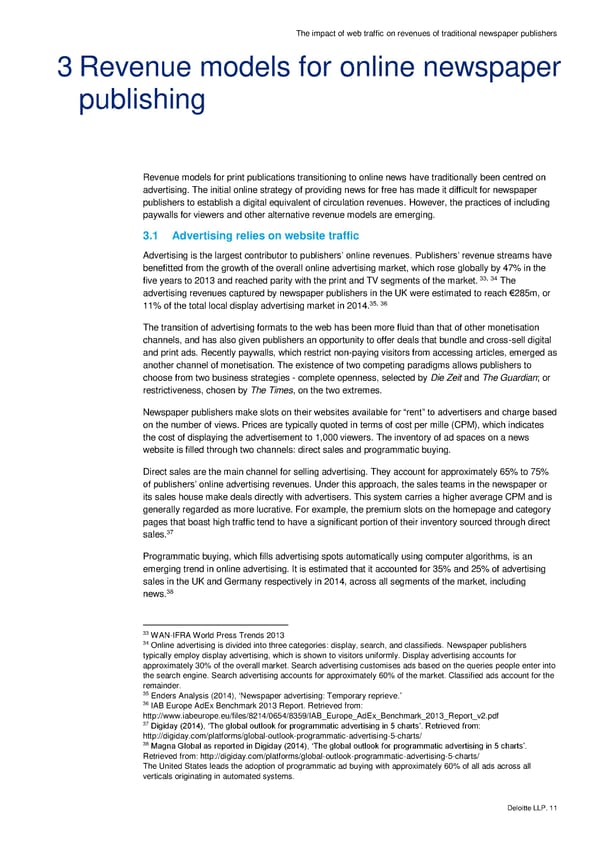The impact of web traffic on revenues of traditional newspaper publishers 3 Revenue models for online newspaper publishing Revenue models for print publications transitioning to online news have traditionally been centred on advertising. The initial online strategy of providing news for free has made it difficult for newspaper publishers to establish a digital equivalent of circulation revenues. However, the practices of including paywalls for viewers and other alternative revenue models are emerging. 3.1 Advertising relies on website traffic Advertising is the largest contributor to publishers’ online revenues. Publishers’ revenue streams have benefitted from the growth of the overall online advertising market, which rose globally by 47% in the 33, 34 five years to 2013 and reached parity with the print and TV segments of the market. The advertising revenues captured by newspaper publishers in the UK were estimated to reach €285m, or 35, 36 11% of the total local display advertising market in 2014. The transition of advertising formats to the web has been more fluid than that of other monetisation channels, and has also given publishers an opportunity to offer deals that bundle and cross-sell digital and print ads. Recently paywalls, which restrict non-paying visitors from accessing articles, emerged as another channel of monetisation. The existence of two competing paradigms allows publishers to choose from two business strategies - complete openness, selected by Die Zeit and The Guardian; or restrictiveness, chosen by The Times, on the two extremes. Newspaper publishers make slots on their websites available for “rent” to advertisers and charge based on the number of views. Prices are typically quoted in terms of cost per mille (CPM), which indicates the cost of displaying the advertisement to 1,000 viewers. The inventory of ad spaces on a news website is filled through two channels: direct sales and programmatic buying. Direct sales are the main channel for selling advertising. They account for approximately 65% to 75% of publishers’ online advertising revenues. Under this approach, the sales teams in the newspaper or its sales house make deals directly with advertisers. This system carries a higher average CPM and is generally regarded as more lucrative. For example, the premium slots on the homepage and category pages that boast high traffic tend to have a significant portion of their inventory sourced through direct 37 sales. Programmatic buying, which fills advertising spots automatically using computer algorithms, is an emerging trend in online advertising. It is estimated that it accounted for 35% and 25% of advertising sales in the UK and Germany respectively in 2014, across all segments of the market, including 38 news. 33 WAN-IFRA World Press Trends 2013 34 Online advertising is divided into three categories: display, search, and classifieds. Newspaper publishers typically employ display advertising, which is shown to visitors uniformly. Display advertising accounts for approximately 30% of the overall market. Search advertising customises ads based on the queries people enter into the search engine. Search advertising accounts for approximately 60% of the market. Classified ads account for the remainder. 35 Enders Analysis (2014), ‘Newspaper advertising: Temporary reprieve.’ 36 IAB Europe AdEx Benchmark 2013 Report. Retrieved from: http://www.iabeurope.eu/files/8214/0654/8359/IAB_Europe_AdEx_Benchmark_2013_Report_v2.pdf 37 Digiday (2014), ‘The global outlook for programmatic advertising in 5 charts’. Retrieved from: http://digiday.com/platforms/global-outlook-programmatic-advertising-5-charts/ 38 Magna Global as reported in Digiday (2014), ‘The global outlook for programmatic advertising in 5 charts’. Retrieved from: http://digiday.com/platforms/global-outlook-programmatic-advertising-5-charts/ The United States leads the adoption of programmatic ad buying with approximately 60% of all ads across all verticals originating in automated systems. Deloitte LLP. 11
 The impact of web traffic on revenues of traditional newspaper publishers Page 17 Page 19
The impact of web traffic on revenues of traditional newspaper publishers Page 17 Page 19